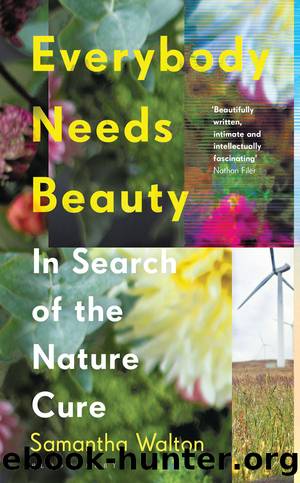Everybody Needs Beauty: In Search of the Nature Cure by Samantha Walton

Author:Samantha Walton [Walton, Samantha]
Language: eng
Format: epub
Tags: nature, Environmental Conservation & Protection, Self-Help, Green Lifestyle, Ecology, Mood Disorders, depression, Medical, General, political science, Public Policy, Environmental Policy
ISBN: 9781526645289
Google: ndYyEAAAQBAJ
Publisher: Bloomsbury Publishing
Published: 2021-07-22T23:46:48.162915+00:00
Life was once again worth living, suffering forgotten. âThis magic art,â he reflected, âmakes a most astonishing impression on the mind; it excites in every heart, not yet insensible to the delightful charms of cultivated nature, all the pleasures which Solitude, rural repose, and a seclusion from the haunts of men, can procure.â In the park, he felt like he was in real nature, wandering alone in the countryside.
The idea struck Olmsted deeply. If all this was the case, surely it was a moral obligation to bring the wonders of nature to the city? In Central Park, which welcomed its first visitors in 1858, Olmsted did just that. Echoing Zimmermann, he believed scenery should work on people through âunconscious influenceâ. The mind and body, the whole human organism, would relax and âunbendâ in perfectly designed surroundings. Park designs should meet deep human needs for restoration and solitude. Their scenery and planting should convey natureâs bounty and mystery, producing effects as innately moving as music.
When Olmsted brought the landscaped park to a rapidly expanding New York, he was setting the standard for the kind of natural beauty that would be valued in a post-Independence, post-Civil War America. What Olmsted made, in effect, was a theme park, where visitors could wander through âzonesâ as aesthetically diverse as Disneyâs Frontierland, Fantasyland or Main Street. Transitions between worlds were marked by subtle design features like regional plants, rugged stone or smart cobbles, and cunningly deflected vistas. To migrants drawn into the vortex of New York, the park could be both a respite and painfully affecting. In James Baldwinâs Go Tell It on the Mountain (1953), Elizabeth, newly arrived from Maryland, realises that she âliked the park because, however spuriously, it re-created something of the landscape she had knownâ. For others, born to city life, the park gave a potted tour of places and terrains they may never have had a chance to see: a curiously compressed landscape of lakes and Ladiesâ Meadows, castle follies and the pocket wilderness of the Ramble.
But what was there before, and what had been lost? When European colonists arrived in the sixteenth century, the isle of Mannahatta had been a vibrant ecology of wetlands and waterways, rocks and forests encompassing âtrees of every descriptionâ, as the English captain Henry Hudson remarked in 1609. But this was no wilderness. The âIsle of Many Hillsâ was home to the Lenni Lenape Indigenous people, and the habitat of wolves, black bears and mountain lions. Long before the lawns of Central Park were laid, these traces were destroyed as Indigenous land was divided up between merchant families, and the haunts of beavers, tree frogs and bog turtles broken and forgotten.
The design of Central Park has preserved a few traces of its geological heritage. The jutting prominence of Rat Rock is a monument to the outcrops of Manhattan schist that were once visible all across the island. But only an information board reminds visitors of the existence of Seneca Village, a community of around
Download
This site does not store any files on its server. We only index and link to content provided by other sites. Please contact the content providers to delete copyright contents if any and email us, we'll remove relevant links or contents immediately.
Spare by Prince Harry The Duke of Sussex(5072)
Machine Learning at Scale with H2O by Gregory Keys | David Whiting(4179)
Fairy Tale by Stephen King(3220)
Will by Will Smith(2793)
Hooked: A Dark, Contemporary Romance (Never After Series) by Emily McIntire(2500)
The Bullet Journal Method by Ryder Carroll(2486)
Rationality by Steven Pinker(2291)
Can't Hurt Me: Master Your Mind and Defy the Odds - Clean Edition by David Goggins(2227)
It Starts With Us (It Ends with Us #2) by Colleen Hoover(2198)
Friends, Lovers, and the Big Terrible Thing by Matthew Perry(2119)
The Becoming by Nora Roberts(2087)
Love on the Brain by Ali Hazelwood(1965)
HBR's 10 Must Reads 2022 by Harvard Business Review(1777)
The Strength In Our Scars by Bianca Sparacino(1776)
A Short History of War by Jeremy Black(1762)
Leviathan Falls (The Expanse Book 9) by James S. A. Corey(1650)
515945210 by Unknown(1599)
A Game of Thrones (The Illustrated Edition) by George R. R. Martin(1589)
Bewilderment by Richard Powers(1539)
